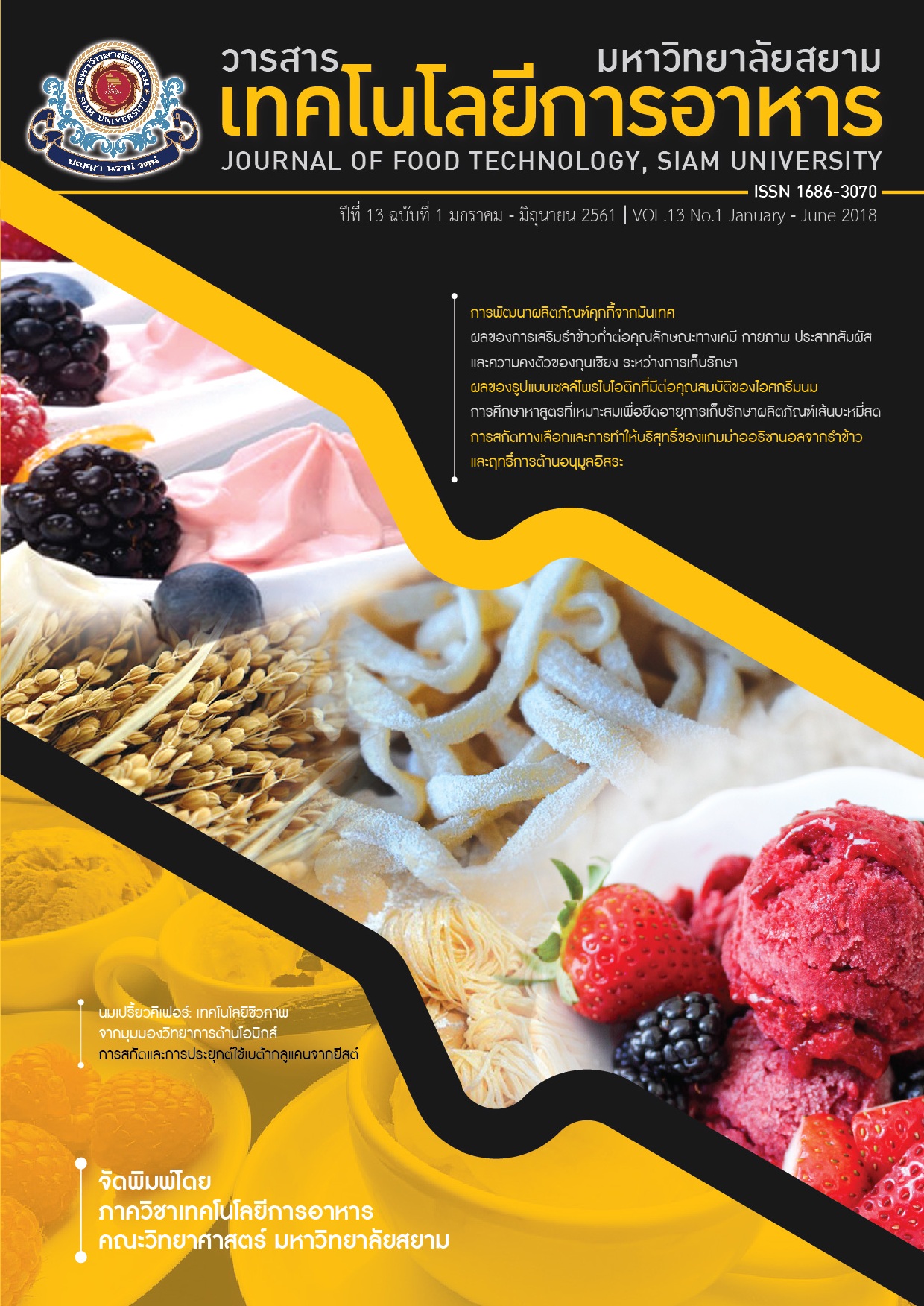Optimization of Fresh Yellow Alkaline Noodle Formulation for Shelf Life Extension
Main Article Content
Abstract
Fresh yellow alkali noodle (YAN) is one of the widely consumed staple foods. YAN also has a unique texture and flavor. However, the shelf life of fresh YAN is relatively short (2-3 days) at room temperature without preservatives. Hence, in this study, we varied amount of sodium carbonate, sodium chloride and glycerol as key ingredients that can effectively prolong YAN’s shelf-life with low impact on its unique quality and used Box-Behnken design to optimize the YAN formulation. Noodles made from all formulations were stored at room temperature and monitored for changes in their characteristics until the day that the total bacteria count was greater than 106 CFU/g. The statistical analysis suggested that the salt and glycerol contents significantly affected the water activity (aw) and the hardness. While the sodium carbonate strongly influenced on the pH value. The shelf-life of YAN was significantly influenced by all the key ingredients. The RSM models were able to describe pH, aw and shelf life properly, thus being appropriate criterial for optimization. There were 27 formulations that were able to increase shelf life of fresh YAN for 2 times. These findings can be utilized by small-medium enterprise for manufacturing preservative-free YAN.
Article Details
Copyrights of all articles in the Journal of Food Technology available in print or online are owned by Siam University and protected by law.
References
[2] Huang, Y.C. and Lai, H.M. (2010). Noodle quality affected by different cereal starches. Journal of Food Engineering. 97: 135–143.
[3] อรอนงค์ นัยวิกุล. (2540). ข้าวสาลี: วิทยาศาสตร์และเทคโนโลยี. สำนักพิมพ์มหาวิทยาลัยเกษตรศาสตร์. กรุงเทพฯ.
[4] กมลรัตน์ รักกิจศิริ. (2549). การศึกษาคุณภาพและการยืดอายุการเก็บรักษาบะหมี่สดไทย. วิทยานิพนธ์วิทยาศาสตรมหาบัณฑิต สาขาวิชาพัฒนาผลิตภัณฑ์ อุตสาหกรรมเกษตร มหาวิทยาลัย เกษตรศาสตร์.
[5] กลุ่มงานวิเคราะห์อาหารและโภชนาการ กองโภชนาการ กรมอนามัย กระทรวงสาธารณสุข. (2544). ตารางแสดงคุณค่าทางโภชนาการอาหารไทย. โรงพิมพ์กองการทหารผ่านศึก. กรุงเทพฯ.
[6] Forsythe, S.J. (2000). The microbiology of safe food. Blackwell Science. Oxford Malden, MA.
[7] Jianming, C. (1998). Preservation of fresh noodles by irradiation, Radiation Physics Chemistry. 52(1-6): 35-38.
[8] Saito K., Nishio, Z., Takata, K., Kuwabara, T., Yokota, A. and Yamauchi, H. (2003). Bacterial adjunct to improve the quality of alkaline noodles. Food Science and Technology Research. 9(1): 40-44.
[9] Li, M., Zhu, K.X., Guo, X., Peng, W., and Zhou, H.M. (2011). Effect of water activity (aw) and irradiation on the shelf-life of fresh noodles. Innovative Food Science Emerging Technology. 12: 526–530.
[10] Mosqueda-Melgar, J., Raybaudi-Massilia, R.M., and Martin-Belloso, O. (2008). Combination of high-intensity pulsed electric fields with natural antimicrobials to inactivate pathogenic microorganisms and extend the shelf-life of melon and watermelon juices. Food Microbiology. 25(3): 479–491.
[11] Rosyid, T. A., Karim, R., Adzahan, N.M. and Ghazali, F.M. (2011). Antibacterial activity of several Malaysian leaves extracts on the spoilage bacteria of yellow alkaline noodles. African Journal of Microbiology Research. 5(8): 898-904.
[12] กาญจนา มหัทธนทวี และ วชิรา คงบรรเจิดสกุล. (2553-2554). การยืดอายุเส้นก๋วยเตี๋ยวสด. วารสารเทคโนโลยีการอาหาร มหาวิทยาลัยสยาม. 6(1): 27-34.
[13] Gontard, N., Guilbert, S. and Cuq, J.L. (1993). Water and glycerol as plasticizers affect mechanical and water vapor barrier of an edible wheat gluten film. Journal of Food Science. 58(1): 206-211.
[14] Kutner, M. Nachtsheim, C., Neter, J. and Li, W. (2004). Applied linear statistical model. McGraw-Hill. New York.
[15] Ghaffar, S., Abdulamir, A.S., Bakar, A.F., Karim, R. and Saari, N. (2009). Microbial growth, sensory characteristic and pH as potential spoilage indicators of Chinese yellow wet noodles from commercial processing plants. American Journal of Applied Sciences. 6(6): 1059-1066.
[16] Association of Official Analytical Chemists (AOAC International). (1990). Official methods of analysis (15th ed.), Washington, D.C.
[17] Derringer, G., and Suich, R. (1980). Simultaneous Optimization of Several Response Variables. Journal of Quality Technology. 12: 214-219.
[18] Fang, F.W., Chin, F.L. and Shih, D.Y.C. (1994). Antifungal activity of chitosan and its preservative effect on low-sugar candied Kumquat. Journal of Food Protection. 57: 136-140.
[19] Del Nobile, M.A., Di Benedetto, N., Suriano N., Conte, A., Lamacchia, C., Corbo, M.R. and Sinigaglia, M. (2009). Use of natural compounds to improve the microbial stability of Amaranth-based homemade fresh pasta. Food Microbiology. 26(2): 151-156.
[20] Davies, J. and Berzonsky, W.A. (2003). Evaluation of spring wheat quality traits and genotypes for production of Cantonese Asian noodles. Crop Science. 43: 1313-1319.
[21] Fuerst, E. P., Anderson, J.V. and Morris, C.F. (2006). Delineating the role of polyphenol oxidase in the darkening of alkaline wheat noodles. Journal Agricultural and Food Chemistry. 54(6): 2378-2384.
[22] Baik, M.Y. and Chinachoti, P. (2003). Water self-diffusion coefficient and staling of white bread as affected by glycerol. Cereal Chemistry. 80(6): 740–744.


